Introduction
What is the meaning of Torticollis?
Torticollis means as “twisted neck” and also known as “wryneck” which cause an abnormal and asymmetrical head or neck position. This is a condition which lead to fibrosis and shortening of the sternocledomastoid (SCM) muscle causing the head to turn or rotate to the side. So the chin points to one shoulder, away from the shortened neck muscle. And the back of the head tilts toward the opposite shoulder. Some cases of congenital torticollis are caused by a bone problem in the neck portion of the spine (cervical spine). This is known as a congenital malformation of the cervical spine.
In newborns, torticollis can happen inside the uterus due to the cramping of a fetus positioning or abnormal positioning (such as being in the breech position, where the baby’s buttocks face the birth canal). The usage of forceps or vacum devices to facilitate the delivery of a baby during childbirth also makes a baby more likely to develop torticollis. This is called infant torticollis or congenital muscular torticollis.
This is a condition which lead to fibrosis and shortening of the sternocledomastoid (SCM) muscle causing the head to turn or rotate to the side. So the chin points to one shoulder, away from the shortened neck muscle. And the back of the head tilts toward the opposite shoulder. Some cases of congenital torticollis are caused by a bone problem in the neck portion of the spine (cervical spine). This is known as a congenital malformation of the cervical spine.
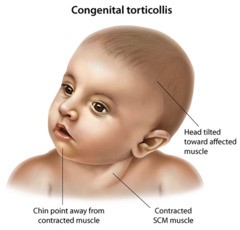 |
| sources : www.fprmed.com |
Prevalence
Mostly torticollis is common in new born. Boys and girls are equally likely to develop the head tilt. It can be present at birth or take up 3 months to develop.
Signs and Symptoms
- The symptoms will present when the babies with torticollis involve in turning activities. He / she might:
- Tilt the head in one direction (this can be difficult to notice in very young infants).
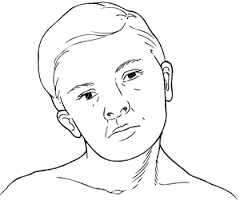
Source : medical-dictionary.thefreedictionary.com - Prefer looking at you over one shoulder instead of turning to follow you with his or her eyes
- If breastfed, have difficulty breastfeeding on one side (or prefers one breast only).
- Work hard to turn toward you and get frustrated when unable turn his or her head completely.
- Some babies with torticollis also will develop a flat head (positional plagiocephaly) on one or both sides from lying in one direction all the time.
- A small lump or bump, which is similar to a “knot” also might occur at the level with the angle of the jaw.
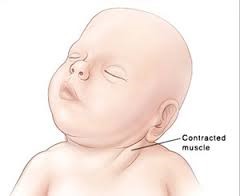 |
| Sources : www.georgia-clinic.com |
- Some babies will also be having neck pain and stiffness during the movement of the neck. The
range of motion will be limited.
Physiotherapy Management
Torticollis babies should be referred to physiotherapy as soon as possible because it is very difficult to perform stretching exercises for older child due to tightness of sternocleidomastoid and increased activity level.
The physiotherapist will assess the child’s condition and prescribe the appropriate positions, exercise or a combination of these for the child.
The physiotherapist will review the child as needed depending on the severity of the condition.
- If the child has a sternocledomastoid muscle lump, he/she will be reviewed 1 to 2 times per week for at least 6 sessions and progress with weekly until the lump has resolved.
- If the child has a tight muscle without a sternocledomastoid muscle lump, weekly therapy for a month and then consequence follow up for 2-3 months is recommended.
Physiotherapy Treatment Includes:
- Passive stretching
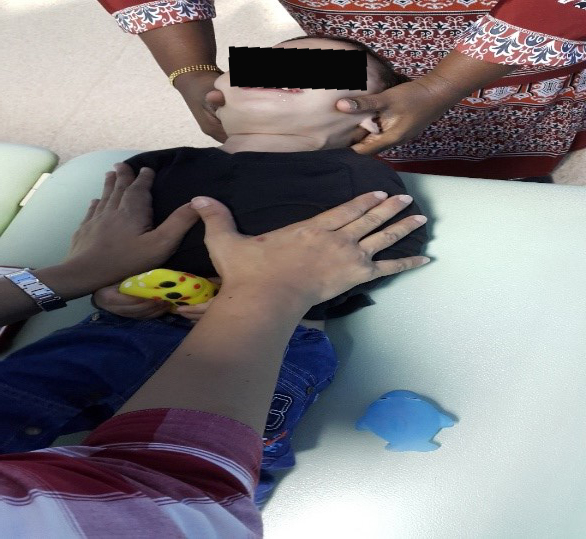 |
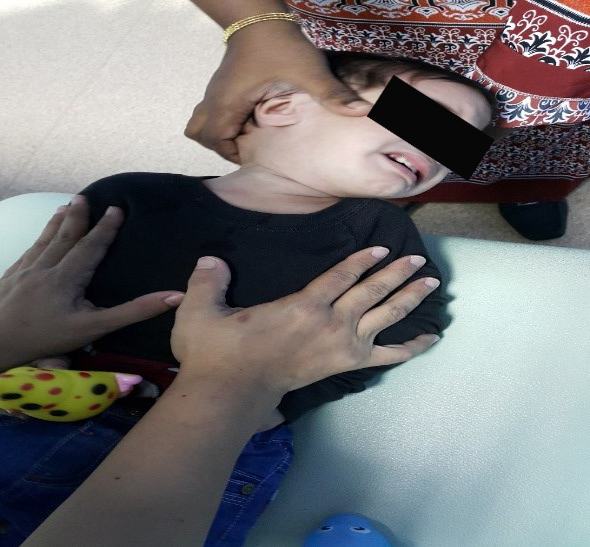 |
Source : Image 2015 – Unit Fisioterapi, Hospital Taiping
- Handling and mobilisation of the head and neck to promote symmetry
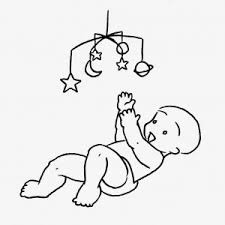 |
| Source : www.pinterest.com |
- Exercises to promote muscle balance
- Positioning and postural advice to parents
- Teaching parents appropriate exercises that can be completed at home
- Use of heat to reduce muscle spasm ( recommended more to older child)
- Use of collars where appropriate (recommended more to older child)
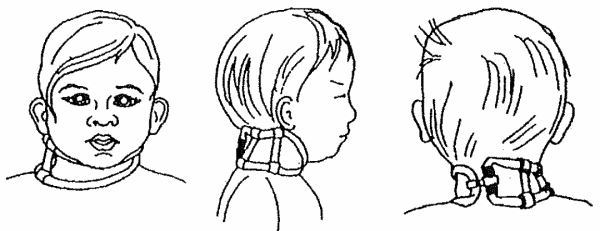 |
| Source : www.pinterest.com |
The stretching exercises should be carried out at least an hour after feeds. Normally the exercises are gentle and when performed correctly should not cause pain. The baby cries because the exercise puts his/her neck in an unusual and uncomfortable position.
Home Exercise Programme
- Play or interact with the child to turn his /her head in both directions to let loosen tense neck muscles and tighten the loose ones.
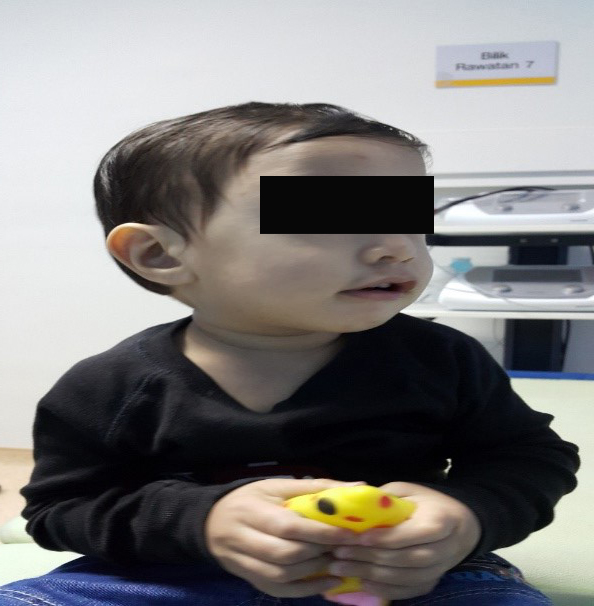 |
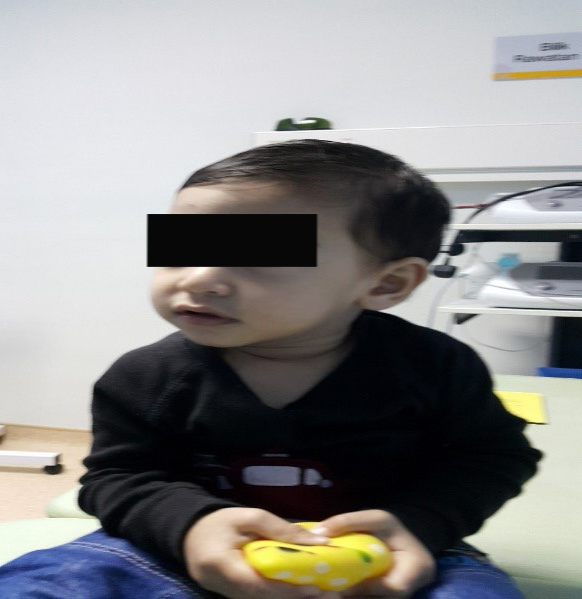 |
Play or interact with the child to turn his /her head in both directions.
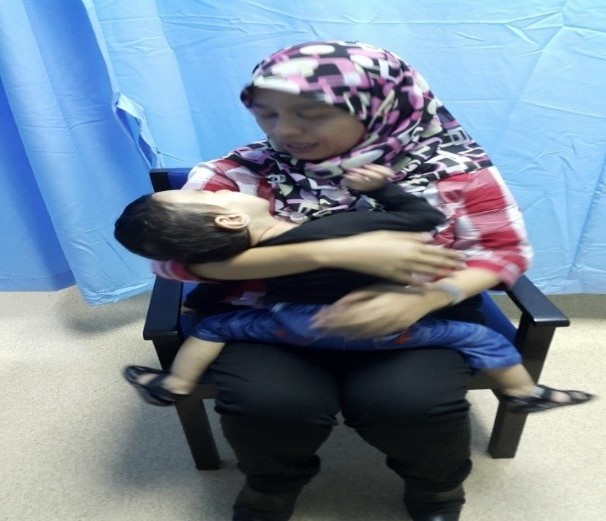 |
|
| Source: Image 2015 – Unit Fisioterapi, Hospital Taiping |
2. During feeding time, offer the bottle or breast in a way that encourages the baby to turn away from the favoured side.
 |
| Feeding at the opposite site |
| Source: Image 2015 – Unit Fisioterapi, Hospital Taiping |
3. During sleeping time, the baby face should be positioned facing the wall. This will enhance the baby to turn away their face and look out onto the room which indirectly will stretch the tightened muscles of the neck.
4. Play with toys and sounds on the opposite side which the child likes so that the child will move the head into both directions.
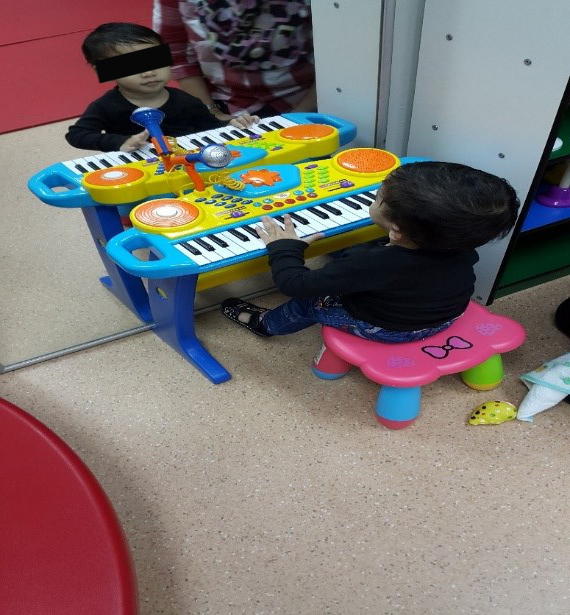 |
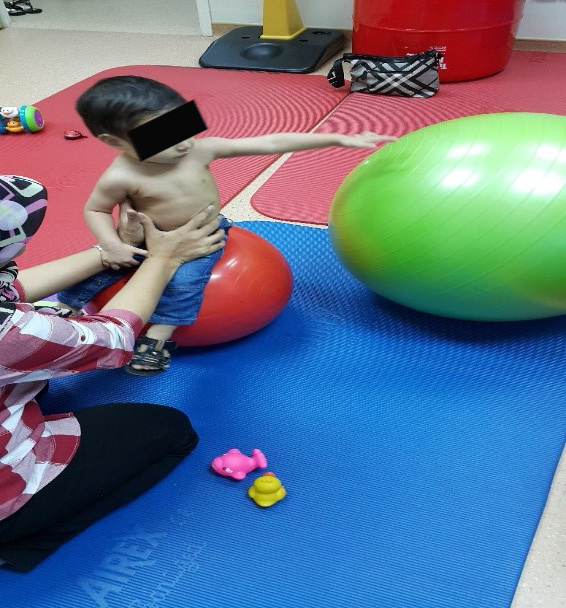 |
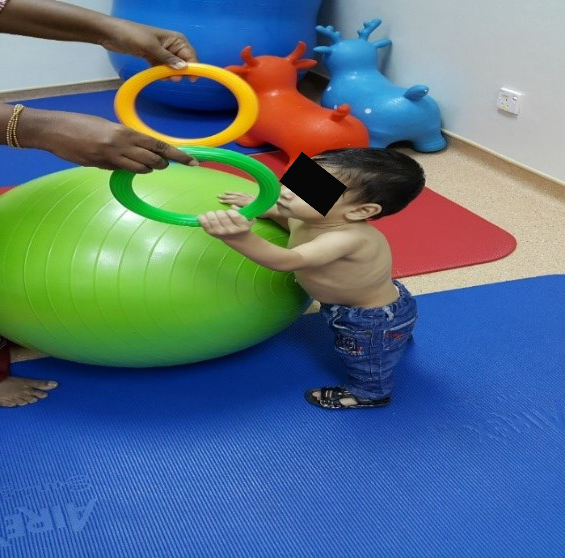 |
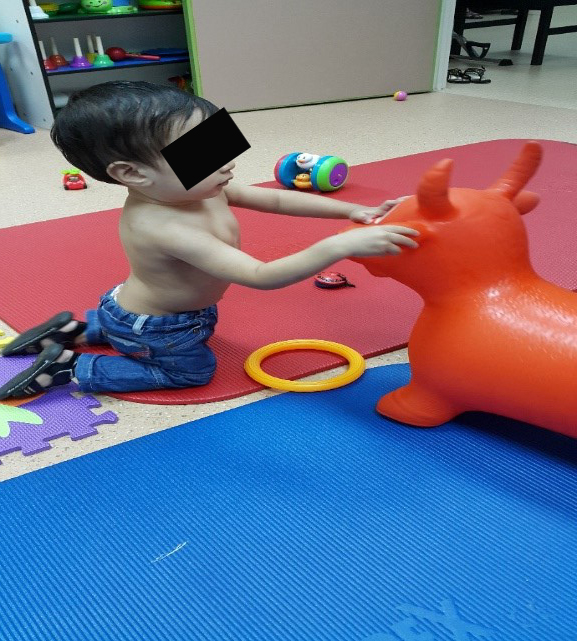 |
Play Therapy
Source: Image 2015 – Physiotherapy Unit, Hospital Taiping
5. Always observe the position of the head in his / her crib, in the car and in resting time. Do not let the baby position his / her head on one side for a long period. Attract the babies attention to turn his/her head in both directions.
How can Torticollis be Resolved?
Studies have shown that torticollis can be resolved through appropriate positioning, simple stretching, active correction and strengthening exercises. Usually this condition will resolves within 1 year if the correction of position and exercises in done daily.
If the babies condition is not resolve within the time frame, the doctor may recommend surgical treatment to release and lengthen the tight muscle.
Safety Precaution
Observe the child and his/her position of the head daily. If there is any abnormality or asymmetrical of the neck position, please look for a doctor/ medical practitioner.
The sooner in babies is detected, the better and more efficiently this condition can be treated.
Why is it important to have Torticollis treated?
It is very important to treat torticollis as early as we can because;
- It can prevent a permanent shortening of the involved muscle. In some cases, we can see an adult torticollis which is not treated early.
- Avoid the need of surgery
- Reduce neck pain
- Prevent secondary concerns such as delayed development motor skills and plagiocephaly
References
- Jeanne H (2007) Orthopaedic Condition 1st ed pg 199-215. Butterworth Heinemann.
- Pamela ME (1993) Elemants of Paediatric 1st ed New York Churchill Livingstone
- Roberta BS (1995) Physiotherapy In Paediatrics 3rd ed Butterworth Heinemann.
- Stuart BP (2003) Tidy’s Physiotherapy 3rd ed Butterworth Heinemann.
Source image
- www.uofmhealth.org 460 x 300
- www.workinggonworkingmom.com 486 x 236
- www.necksolutions.com 466 x 354
- (2015) Unit Fisioterapi Hospital Taiping. Retrieved July 2015.
| Last Reviewed | : | 23 August 2019 |
| Writer / Translator | : | Kogilavani a/p S.Krishnan |
| Accreditor | : | Se To Phui Lin |
| Reviewer | : | Halimah bt. Hashim |







